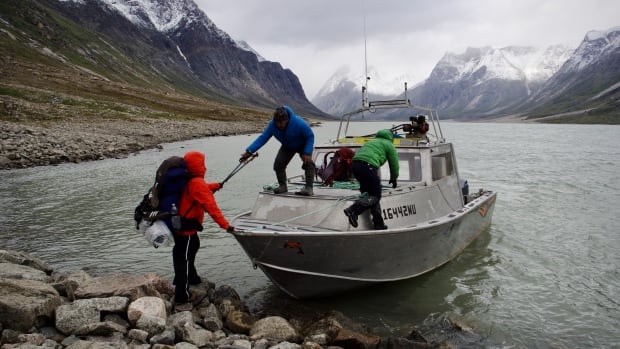Since the end of COVID-19, tourism numbers to Nunavut have started to recover.
At one park alone, visitor numbers for 2023-24 are at 77 per cent of last season, before the pandemic hit, according to data provided by Parks Canada.
“We had 253 visitors last year,” said Leanna Ellsworth, manager of Auyuittuq National Park. “Every year we get up to 300 visitors.”
Of Nunavut’s five national parks, Auyuittuq National Park is the most popular, Ellsworth said.
But national parks aren’t the only thing that draws tourists.
Cruise ships also call at areas of Nunavut such as Pond Inlet.
“We got off to a little bit of a slow start post-pandemic,” said Dylan Mavrick, economic development officer for Pond Inlet. “We didn’t have a lot of cruise ships coming in, but then it started to pick up.”
Mavrick said he didn’t know what the situation was pre-pandemic, but said 20 cruise ships are expected to visit the region in 2022, with that total rising to 30 by 2023.
People boat in Eclipse Sound, outside Pond Inlet, Nunavut, with Bylot Island in the background. The village’s economic development officer says cruise ships have returned to Pond Inlet since the pandemic ended. (David Gunn/CBC)
But the cruise ship visits have created some rifts in the community.
Some local residents rely on tourist dollars and summer cruise ship visits to provide for their families and communities, but others say the cruise ships cause significant damage to the environment and ecosystem, with knock-on effects on hunting.
Mavrick said he understands both sides of the debate and that local hunter and trapper groups have worked with the cruise company to help develop a plan that could mitigate the impact.
Previously, ships leaving Pond Inlet traveled west through Nunavut waters, impacting snow and ice and the local narwhal population. Now, ships travel east through Baffin Bay.
Local tourism booms
As both Ellsworth and Mavrick noted, Nunavut’s tourism industry has been devastated by the pandemic.
But the region’s tourism industry association says it is seeing an increase in membership compared to before the pandemic.
“Compared to pre-COVID-19, we’ve seen a 12 per cent increase in membership of Inuit-owned businesses,” said Travel Nunavut acting executive director Norrin Naguib.
Noreen Naguib is the acting executive director of Travel Nunavut, who said the organization’s membership has been growing since before the COVID-19 pandemic. (TJ Deal/CBC)
Naguib also said the association currently has 120 members, 82 of which are Inuit-owned businesses, and expects membership to exceed 150 by the end of the year.
She said there has also been an increase in tourists seeking Indigenous tourism.
“That’s reflected in the Canadian government’s commitment to Indigenous tourism this year in the federal budget,” Naguib said. “We’re really looking forward to helping our members seize the opportunities that are available there.”
As public awareness rises, so will demand.
The donation is valued at $2.5 million, according to the Indigenous Tourism Association of Canada (ITAC), which will administer the funds across the country. Indigenous Tourism Association president and CEO Keith Henry said in a press release that it demonstrates Ottawa’s commitment to Indigenous tourism.
“Indigenous-led destinations and packages are becoming incredibly popular,” he told CBC News in an interview. “Twenty years ago, these packages might have been completely novel.”
Henry said he expects Indigenous tourism in Canada to return to 2019 levels of about $2 billion.
 Keith Henry, president and CEO of the Native American Tourism Association of Canada, said Indigenous-led destinations and packages are more popular now than they were 20 years ago.(Christian Amundson/CBC)
Keith Henry, president and CEO of the Native American Tourism Association of Canada, said Indigenous-led destinations and packages are more popular now than they were 20 years ago.(Christian Amundson/CBC)
He said there has been a “huge change in what we call consumer behavior” when it comes to tourists, and one of the reasons behind this is that people are becoming more aware of the world they live in.
“I think people are recognising Indigenous culture and values as something that we should probably look at more closely,” Henry said of the change in public attitudes.
Henry said another reason for the increase is the discovery of hundreds of unmarked graves at former residential school sites across the country, which he said has made Canadians aware of the country’s history.
“We’ve seen a significant increase in interest across the country in exploring and learning more about Indigenous peoples,” Henry says, “not just visual or artistic learning, but understanding the evolution of communities and the history we’ve been through as a nation as part of reconciliation.”
In Nunavut, ITAC has provided about $900,000 to Travel Nunavut and local businesses since 2021, but demand remains high, Henry said.
“We’re looking to continue our plan to create 47 new businesses and hire 1,000 new employees by 2030, with hopefully Inuit employees facilitating cultural adventures and cultural experiences and sharing Inuit culture as much as the community wants to support,” he said. “There’s still a lot of work to be done in Nunavut, but we need many partners to make it happen.”

